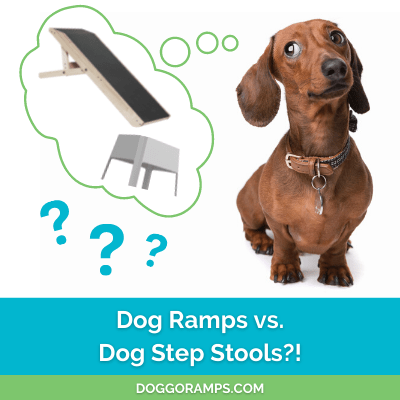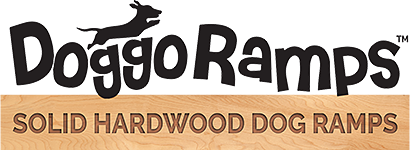Dog Step Stool vs. Dog Ramp

As the owner of a small or medium-sized dog, you’ve probably noticed that getting on and off furniture requires quite the leap.
You may have even started looking into introducing your dog to an assistive device, such as an indoor ramp, to provide them with a safe alternative to jumping and help protect their back and joints.
While pet stairs and ramps tend to be two of the most popular options out there, you may have also come across a dog step stool while looking for the perfect solution for your pet.
So if you find yourself investigating the differences between a dog step stool and a dog ramp, read on to discover the benefits and challenges that come with each device.
And should you be looking for a solution that combines the advantages of a pet ramp with the perks of a pet step, make sure to read right until the end.
Step Stools for Pets vs. Pet Stairs: What’s the Difference?
Before we begin evaluating pet step stools in comparison to ramps, we want to highlight the difference between pet stairs and step stools.
Pet stairs are usually made up of a set of 2-4 steps to help dogs and other household pets get on and off couches or beds. (If you’ve been looking into pet stairs as well, we have a separate guide comparing dog stairs vs. dog ramps.)
On the other hand, step stools for pets are often even more compact than pet stairs and typically consist of a single step. Occasionally, dog step stools may feature a second step.

Functionality
When choosing between a dog step stool and a dog ramp, it’s important to determine how practical each option will be for your pup and space.
Here are some key factors to consider:
How easy will it be for your dog to use a dog step vs. a ramp?
Your Dog’s Age and Activity Levels
One of the first things you should take into account when choosing an assistive device for your dog is their age and physical ability.
Both dog step stools and dog ramps can help dogs reach their favorite hangout spots.
However, step stools work best for young, active, and physically fit dogs. While they can provide pups with a helping step up and down and decrease the amount of strain they put on their backs and joints, step stools still require dogs to manage small jumps to get on and off the device. These small hops may prove to be too demanding for senior dogs, arthritic dogs, and dogs recovering from an injury or surgery. In these cases, a dog ramp will be the better fit as its gradual incline will be easier and more comfortable for your pup.
Another way to determine whether a step stool could work for your dog is to consider whether they are capable of safely and confidently using stairs. If so, a pet step may be fine, but if they find navigating stairs challenging or shouldn’t be using them, a dog ramp is the way to go.
Last but not least, it’s also helpful to acknowledge how your dog’s activity levels and abilities may change in the next few years. As dogs age, they may no longer be able to hop and leap like they used to. A dog step stool may only end up being a short-term solution for your pup, while a ramp can be used for life.

Your Dog’s Size and Proportions
It shouldn’t come as a surprise that jumping off furniture usually poses more risks for small dogs compared to larger breeds. That’s because the distance from the couch or bed to the floor can easily be 2-3 times greater than a small dog’s height. Jumping such a distance puts significantly more strain on a tiny pup’s back and joints compared to a bigger dog jumping from the same height.
Even with a step stool (which usually serves as a midway point between the couch/bed and the floor), a toy or miniature breed may still be required to jump a distance that’s greater than the length of their legs. This ends up putting extra stress on their tiny bodies. On the other hand, small breeds don’t run into this issue with dog ramps as jumping or hopping isn't necessary to use a ramp.

Fixed vs. Adjustable Height
When choosing between a dog step vs. a ramp, it’s also important to determine how each device will work with your furniture.
Even when foldable, most dog steps and step stools on the market only offer one static, fixed height. Having a step stool that’s a few inches too short or tall for your couch or bed can impact your dog’s ability and willingness to use it. Fortunately, well-made dog ramps, such as DoggoRamps Couch Ramps and Bed Ramps, feature a variety of height settings to match your furniture. DoggoRamps specifically have a wide range of height options so they can be set up with virtually any couch or bed.

Space Available
So far, dog ramps have proven to be a better fit for a greater variety of dogs, couches, and beds. However, there’s one area where dog step stools have an advantage; step stools for pets are usually more compact and take up less floor space than dog ramps. This makes dog steps a popular choice for pet owners who don’t have enough space for full-fledged ramps.
Fortunately, should a dog ramp be a better option for your pup, DoggoRamps Couch Ramps and Bed Ramps can set up in different ways in order to be a better match for your layout and space. Just take a look at the examples comparing step stool and ramp placement below:


Storage and Transportation

While a dog step stool is smaller than a dog ramp, it usually has a pre-assembled and fixed structure. This can make step stools a bit trickier to store in comparison to pet ramps that can be folded flat and easily tucked under the couch or bed.
It’s also becoming increasingly common for pet owners to travel with their pups and take their pet ramps, stairs, or step stools too. Packing stairs or step stools may sometimes turn into a game of Tetris, but packing a ramp that’s been folded flat to just 3” doesn’t typically pose the same issue.
Likelihood for Consistent Use
When trying to access different places, dogs like to choose the easiest and most convenient route. This means that most dogs will use the most comfortable and least demanding path to get to where they want to go.
However, when excited or focused on a particular goal, many dogs will opt for the quickest route.
Pet stairs and step stools typically need to be used with greater attention and care, so the chances of a dog simply leaping over their step stool are higher if they’re in a rush.
On the other hand, pet ramps can be used quickly or slowly, so as long as a dog ramp is smartly positioned along one of your pup’s most frequented routes, it will be possible for your dog to use their ramp whether they’re relaxed or in a rush.

Is a dog ramp safer than a dog step stool?
Yes. The majority of pet owners start looking into getting an assistive device for their dog in order help to protect their pup's backs and joints from jumping-related complications. Compared to pet stairs or a dog step stool, a dog ramp is the only option that is entirely impact-free.
Of course, pet stairs or step stools are better than nothing, but they still require dogs to sustain smaller repeated impacts over time. This ends up putting extra stress on their backs and joints which can be avoided with dog ramps.

Make Sure to Consider your Dog’s Susceptibility to Joint and Back Issues
Choosing a ramp over stairs or a step stool can make a big difference for breeds prone to joint and back problems. This includes many toy breeds, such as Yorkshire Terriers, Chihuahuas, and Shih Tzus, that are susceptible to Patellar Luxation and large breeds, such as Labrador Retrievers, German Shepherds, and Saint Bernards, that have a higher risk of developing hip or elbow dysplasia. Of course, dog ramps are also a better fit for short-legged, long-bodied dogs, such as Dachshunds, Corgis, and Basset Hounds, that are prone to Intervertebral Disc Disease (IVDD).
Reducing the amount of impact these breeds experience - even by opting for a ramp over a pet step - can play a role in protecting their backs and joints and help them enjoy a higher quality of life.
What If You Just Don’t Have Enough Space for a Full-Fledged Dog Ramp?
We hear you! Since dog ramps take up quite a bit more space than dog step stools, they won’t always work with everyone’s setup. However, many dog owners still want to provide the best possible solution for their pets to help protect their backs and joints. That’s why we created the New DoggoRamps StepRamp.
The StepRamp is a compromise solution between pet stairs and a dog ramp, and it combines the space efficiency of a dog step with the ease of using a dog ramp. Instead of having multiple steps to climb (pet stairs) or a single, levelled platform to hop onto and off (a step stool), the StepRamp features one small step at the bottom with a gentle incline leading up to a height of 14” at the opposite end.

@itsadaphneday uses her DoggoRamps StepRamp to walk down from the couch.
We call the StepRamp a “compromise” solution since it does require dogs to navigate a small step at the bottom. However, the distance from the bottom of the ramp to the floor (6") is less than a traditional house step (7"). So with only one hop required and a gradual slope guiding your pup to and from their favorite hangout spot, the StepRamp can be a more joint and back-friendly option than pet stairs or a step.
Measuring 17” wide and 14” deep with a built-in storage cubby hole, the DoggoRamps StepRamp is the perfect fit for more compact living spaces too!
 Crusoe's StepRamp helps keep his toys all in one place.
Crusoe's StepRamp helps keep his toys all in one place.
Summary: Comparing Dog Step Stools to Dog Ramps (and the StepRamp)

Out of all the assistive devices out there, dog ramps are the safest and most versatile option for dogs - especially for breeds with higher risks of developing joint and back issues.
However, from customer inquiries and our own research, we know that:
- Some pet owners don’t have the space for a full-fledged ramp.
- Some dogs don’t need a full-fledged ramp.
Our aim with this guide is to provide you with the information needed to make the best decision for you and your pup.
And to learn more about which DoggoRamp would be the best option for your dog, make sure to check out our:
- StepRamp for All Dogs
- Couch Ramp for All Dogs
- Bed Ramp for Small Dogs
- Bed Ramp for Medium-Sized and Large Breeds
Happy Ramping!
Leave a comment
Comments will be approved before showing up.




